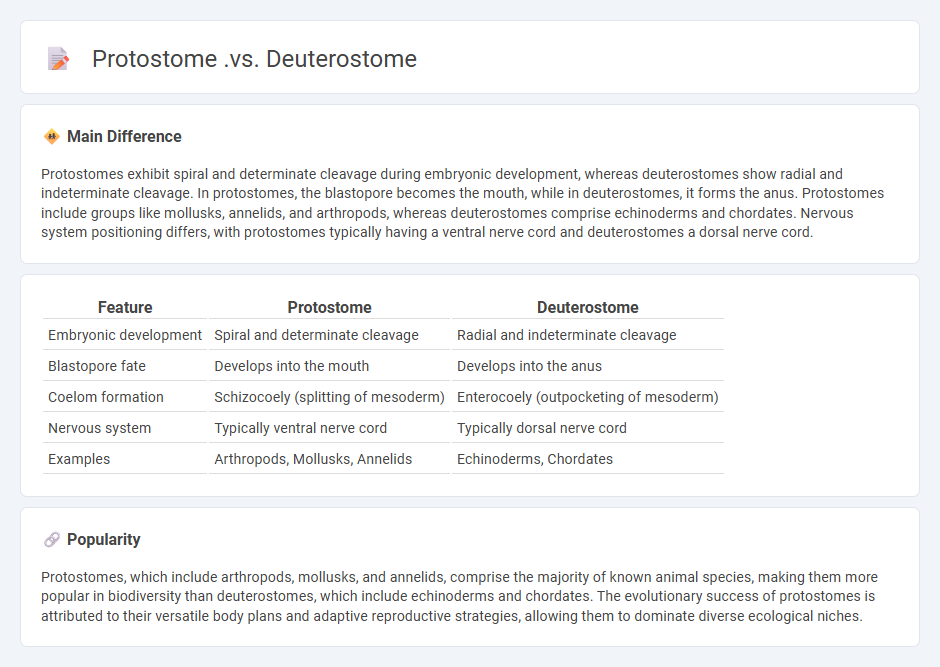
Protostomes and deuterostomes represent two major evolutionary lineages distinguished by their embryonic development patterns, particularly the fate of the blastopore. In protostomes, the blastopore develops into the mouth, while in deuterostomes, it becomes the anus, influencing the body plan and organ formation. Explore the differences in developmental biology and evolutionary significance to deepen your understanding of these crucial animal groups.
Main Difference
Protostomes exhibit spiral and determinate cleavage during embryonic development, whereas deuterostomes show radial and indeterminate cleavage. In protostomes, the blastopore becomes the mouth, while in deuterostomes, it forms the anus. Protostomes include groups like mollusks, annelids, and arthropods, whereas deuterostomes comprise echinoderms and chordates. Nervous system positioning differs, with protostomes typically having a ventral nerve cord and deuterostomes a dorsal nerve cord.
Connection
Protostomes and deuterostomes are connected through their shared classification as Bilateria, organisms characterized by bilateral symmetry and three germ layers. Both groups exhibit distinct embryonic development patterns: protostomes develop the mouth from the blastopore, while deuterostomes form the anus first. Their evolutionary divergence highlights fundamental differences in developmental biology that clarify the complexity of animal phylogeny.
Comparison Table
| Feature | Protostome | Deuterostome |
|---|---|---|
| Embryonic development | Spiral and determinate cleavage | Radial and indeterminate cleavage |
| Blastopore fate | Develops into the mouth | Develops into the anus |
| Coelom formation | Schizocoely (splitting of mesoderm) | Enterocoely (outpocketing of mesoderm) |
| Nervous system | Typically ventral nerve cord | Typically dorsal nerve cord |
| Examples | Arthropods, Mollusks, Annelids | Echinoderms, Chordates |
Blastopore Fate
The blastopore is an essential structure formed during the early embryonic development of many animals, marking the site where gastrulation begins. In protostomes, the blastopore develops into the mouth, whereas in deuterostomes, it becomes the anus. This fundamental difference plays a crucial role in distinguishing major animal phyla such as mollusks and annelids (protostomes) from echinoderms and chordates (deuterostomes). Understanding blastopore fate sheds light on evolutionary relationships and developmental biology mechanisms across species.
Cleavage Pattern
Cleavage pattern in biology refers to the series of rapid mitotic cell divisions following fertilization in embryonic development. These divisions partition the zygote into smaller cells called blastomeres without increasing the overall size of the embryo. Different organisms exhibit characteristic cleavage patterns, such as radial cleavage in echinoderms and spiral cleavage in annelids. The pattern influences the formation of the blastula and subsequent developmental processes.
Coelom Formation
Coelom formation refers to the development of a fluid-filled body cavity within the mesoderm layer during embryogenesis in many multicellular organisms. This cavity serves as a space for the internal organs, allowing for greater complexity and specialization in organ development and function. There are three primary modes of coelom formation: schizocoely in protostomes, enterocoely in deuterostomes, and a coelom that forms by splitting of the mesodermal mass. The presence and type of coelom are critical factors in animal classification and influence the organism's physiology and evolutionary adaptations.
Embryonic Development
Embryonic development involves the complex sequence of cellular division, differentiation, and morphogenesis that transforms a fertilized egg into a multicellular organism. Key stages include cleavage, blastulation, gastrulation, and organogenesis, each critical for establishing the body plan and organ systems. Model organisms such as zebrafish (Danio rerio), fruit flies (Drosophila melanogaster), and mice (Mus musculus) provide valuable insights into genetic regulation and embryonic patterning. Understanding embryonic development is essential for advancements in regenerative medicine, congenital defect research, and developmental biology.
Evolutionary Lineages
Evolutionary lineages trace the ancestral descent of organisms through successive generations, highlighting genetic continuity and divergence over time. These lineages are reconstructed using molecular phylogenetics, fossil records, and comparative anatomy to map species relationships and evolutionary history. Understanding evolutionary lineages is crucial for studying speciation events and adaptive radiation across diverse taxa. Genomic data from databases such as GenBank and Tree of Life Web Project strengthen the accuracy of lineage analysis.
Source and External Links
Difference Between Protostomes And Deuterostomes - BYJU'S - In protostomes, the blastopore develops into the mouth, while in deuterostomes it becomes the anus, and protostomes show determinate cleavage whereas deuterostomes exhibit indeterminate cleavage.
13.21: Embryological Development - Biology LibreTexts - Protostomes (e.g., arthropods, mollusks) form their coelom by schizocoely (splitting mesoderm) and undergo spiral cleavage, while deuterostomes (e.g., chordates) form their coelom by enterocoely (mesoderm pouches from gut) and undergo radial cleavage.
Protostomes versus Deuterostomes - Most coelomate invertebrates are protostomes where the mouth forms from the blastopore, whereas deuterostomes (including echinoderms and chordates) form the anus from the blastopore and the mouth from a second opening.
FAQs
What are protostomes and deuterostomes?
Protostomes are a group of animals characterized by the mouth developing from the embryonic blastopore, including arthropods, mollusks, and annelids; deuterostomes are animals where the blastopore becomes the anus, comprising echinoderms and chordates.
How do protostomes and deuterostomes differ in embryonic development?
Protostomes develop the mouth from the blastopore and exhibit spiral, determinate cleavage, while deuterostomes develop the anus from the blastopore and exhibit radial, indeterminate cleavage.
Which animals are classified as protostomes?
Protostomes include arthropods, mollusks, annelids, and nematodes.
Which animals are classified as deuterostomes?
Animals classified as deuterostomes include echinoderms (such as sea stars and sea urchins), hemichordates (acorn worms), and chordates (vertebrates like mammals, birds, reptiles, amphibians, and fish).
What is the fate of the blastopore in protostomes and deuterostomes?
In protostomes, the blastopore develops into the mouth; in deuterostomes, the blastopore forms the anus.
How do their coelom formation processes differ?
Protostomes form their coelom through schizocoely by splitting mesodermal tissue, while deuterostomes develop their coelom via enterocoely by outpocketing the primitive gut.
Why is distinguishing between protostomes and deuterostomes important in biology?
Distinguishing between protostomes and deuterostomes is important because it reveals fundamental differences in embryonic development patterns, including cleavage, blastopore fate, and coelom formation, which underpin the evolutionary relationships and classification of major animal phyla.
 calledges.com
calledges.com